过去分词
- 格式:wps
- 大小:56.50 KB
- 文档页数:4
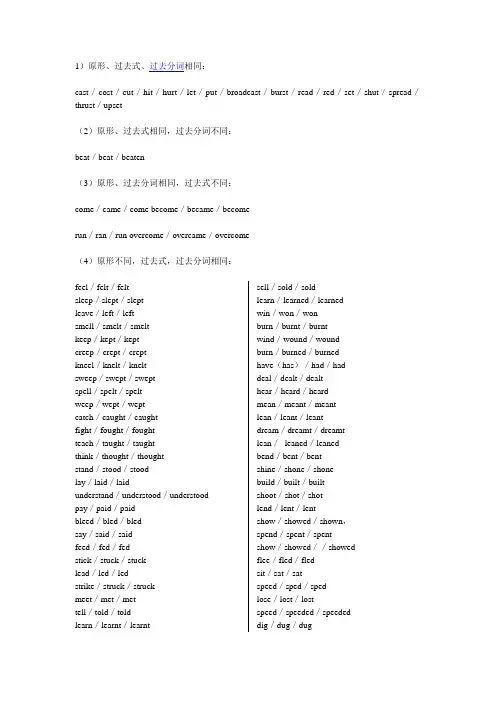
1)原形、过去式、过去分词相同:cast/cost/cut/hit/hurt/let/put/broadcast/burst/read/red/set/shut/spread/thrust/upset(2)原形、过去式相同,过去分词不同:beat/beat/beaten(3)原形、过去分词相同,过去式不同:come/came/come become/became/becomerun/ran/run overcome/overcame/overcome(4)原形不同,过去式,过去分词相同:feel/felt/feltsleep/slept/sleptleave/left/leftsmell/smelt/smeltkeep/kept/keptcreep/crept/creptkneel/knelt/kneltsweep/swept/sweptspell/spelt/speltweep/wept/weptcatch/caught/caughtfight/fought/foughtteach/taught/taughtthink/thought/thoughtstand/stood/stoodlay/laid/laidunderstand/understood/understood pay/paid/paidbleed/bled/bledsay/said/saidfeed/fed/fedstick/stuck/stucklead/led/ledstrike/struck/struckmeet/met/mettell/told/toldlearn/learnt/learnt sell/sold/soldlearn/learned/learned win/won/wonburn/burnt/burntwind/wound/wound burn/burned/burned have(has)/had/had deal/dealt/dealthear/heard/heard mean/meant/meant lean/leant/leantdream/dreamt/dreamt lean/leaned/leaned bend/bent/bentshine/shone/shone build/built/builtshoot/shot/shotlend/lent/lentshow/showed/shown,spend/spent/spent show/showed//showed flee/fled/fledsit/sat/satspeed/sped/spedlose/lost/lostspeed/speeded/speeded dig/dug/dugspit/spit/spithold/held/heldspit/spat/spatget/got/got(AmE gotten)bring/brought/brought find/found/foundlight/lit/litmake/made/madelight/lighted/lightedbuy/bought/bought(5)三者均不同:drive/drove/drivenblow/blew/blownrise/rose/risenfly/flew/flownwake woke/wokengrow/grew/growndo/did/doneknow/knew/knowngo/went/gonethrow/threw/thrownsee/saw/seenprove/proved/proveneat/ate/eaten break/broke/brokenfall/fell/fallenchoose/chose/chosen give/gave/givenfreeze/froze/frozen shake/shook/shaken speak/spoke/spokentake/took/takensteal/stole/stolen mistake/mistook/mistaken weave/wove/woven forbid/forbad/forbidden begin/began/begun forget/forgot/forgotten drink/drank/drunkride/rode/riddenring/rang/runghide/hid/hiddensing/sang/sungwrite/wrote/writtensink/sank/sunkwear/wore/wornswim/swam/swum(6)相同动词因其过去式、过去分词有两形式而产生不同词义:speed过去式、过去分词有两种:sped/sped快行speeded/speeded加速light过去式,过去分词有两种:lit/lit点着(表语)lighted/lighted供电,点燃的(定语)shine过去式、过去分词有两种:shone/shone/照耀shined/shined擦亮hang过去式、过去分词有两种:hung/hung悬挂hanged/hanged绞死(7)drunken,stricken,sunken已转为形容词常作定语a~sot酒鬼in a~manner摇摇晃晃地(8)lie躺卧lay/lain/lying(现在分词)lie撒谎lied/lied/lyinglay放,下蛋laid/laid/laying(9)come,become,overcome属不规则变化,但welcome属规则动词,其过去式、过去分词为:welcomed,welcomed(10)fly,blow不是规则变化,但flow(流)是规则变化,过去式、过去分词为flowed,flowed.(11)find发现found foundfound创建founded foundedwind绕wound woundwound伤害wounded woundedsee看见saw seensaw锯sawed sawedbear作“出生”,过去分词有两种:born,borne,borne用于have之后及带有by的被动句中;born用于be born in/on/at中。
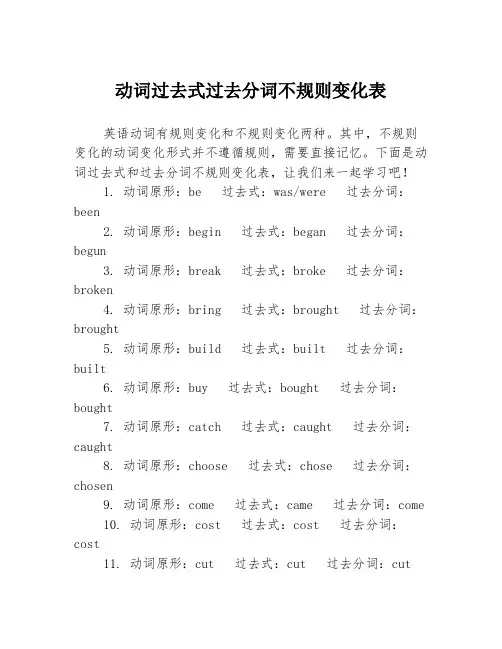
动词过去式过去分词不规则变化表英语动词有规则变化和不规则变化两种。
其中,不规则变化的动词变化形式并不遵循规则,需要直接记忆。
下面是动词过去式和过去分词不规则变化表,让我们来一起学习吧!1. 动词原形:be 过去式:was/were 过去分词:been2. 动词原形:begin 过去式:began 过去分词:begun3. 动词原形:break 过去式:broke 过去分词:broken4. 动词原形:bring 过去式:brought 过去分词:brought5. 动词原形:build 过去式:built 过去分词:built6. 动词原形:buy 过去式:bought 过去分词:bought7. 动词原形:catch 过去式:caught 过去分词:caught8. 动词原形:choose 过去式:chose 过去分词:chosen9. 动词原形:come 过去式:came 过去分词:come10. 动词原形:cost 过去式:cost 过去分词:cost11. 动词原形:cut 过去式:cut 过去分词:cut13. 动词原形:draw 过去式:drew 过去分词:drawn14. 动词原形:drink 过去式:drank 过去分词:drunk15. 动词原形:drive 过去式:drove 过去分词:driven16. 动词原形:eat 过去式:ate 过去分词:eaten17. 动词原形:fall 过去式:fell 过去分词:fallen18. 动词原形:feel 过去式:felt 过去分词:felt19. 动词原形:find 过去式:found 过去分词:found20. 动词原形:fly 过去式:flew 过去分词:flown21. 动词原形:forget 过去式:forgot 过去分词:forgotten22. 动词原形:get 过去式:got 过去分词:gotten23. 动词原形:give 过去式:gave 过去分词:given24. 动词原形:go 过去式:went 过去分词:gone25. 动词原形:grow 过去式:grew 过去分词:grown26. 动词原形:hang 过去式:hung 过去分词:hung28. 动词原形:hear 过去式:heard 过去分词:heard29. 动词原形:hide 过去式:hid 过去分词:hidden30. 动词原形:hit 过去式:hit 过去分词:hit31. 动词原形:hold 过去式:held 过去分词:held32. 动词原形:hurt 过去式:hurt 过去分词:hurt33. 动词原形:keep 过去式:kept 过去分词:kept34. 动词原形:know 过去式:knew 过去分词:known35. 动词原形:lay 过去式:laid 过去分词:laid36. 动词原形:lead 过去式:led 过去分词:led37. 动词原形:leave 过去式:left 过去分词:left38. 动词原形:let 过去式:let 过去分词:let39. 动词原形:lie 过去式:lay 过去分词:lain40. 动词原形:lose 过去式:lost 过去分词:lost41. 动词原形:make 过去式:made 过去分词:made42. 动词原形:mean 过去式:meant 过去分词:meant43. 动词原形:meet 过去式:met 过去分词:met45. 动词原形:put 过去式:put 过去分词:put46. 动词原形:read 过去式:read 过去分词:read47. 动词原形:ride 过去式:rode 过去分词:ridden48. 动词原形:ring 过去式:rang 过去分词:rung49. 动词原形:rise 过去式:rose 过去分词:risen50. 动词原形:run 过去式:ran 过去分词:run51. 动词原形:say 过去式:said 过去分词:said52. 动词原形:see 过去式:saw 过去分词:seen53. 动词原形:sell 过去式:sold 过去分词:sold54. 动词原形:send 过去式:sent 过去分词:sent55. 动词原形:set 过去式:set 过去分词:set56. 动词原形:shake 过去式:shook 过去分词:shaken57. 动词原形:shine 过去式:shone 过去分词:shone58. 动词原形:shoot 过去式:shot 过去分词:shot59. 动词原形:show 过去式:showed 过去分词:shown60. 动词原形:shut 过去式:shut 过去分词:shut61. 动词原形:sing 过去式:sang 过去分词:sung62. 动词原形:sink 过去式:sank 过去分词:sunk63. 动词原形:sit 过去式:sat 过去分词:sat64. 动词原形:sleep 过去式:slept 过去分词:slept65. 动词原形:speak 过去式:spoke 过去分词:spoken66. 动词原形:spend 过去式:spent 过去分词:spent67. 动词原形:stand 过去式:stood 过去分词:stood68. 动词原形:steal 过去式:stole 过去分词:stolen69. 动词原形:swim 过去式:swam 过去分词:swum70. 动词原形:take 过去式:took 过去分词:taken71. 动词原形:teach 过去式:taught 过去分词:taught72. 动词原形:tear 过去式:tore 过去分词:torn73. 动词原形:tell 过去式:told 过去分词:told74. 动词原形:think 过去式:thought 过去分词:thought75. 动词原形:throw 过去式:threw 过去分词:thrown76. 动词原形:understand 过去式:understood 过去分词:understood77. 动词原形:wake 过去式:woke 过去分词:woken78. 动词原形:wear 过去式:wore 过去分词:worn79. 动词原形:win 过去式:won 过去分词:won80. 动词原形:write 过去式:wrote 过去分词:written以上就是动词过去式和过去分词不规则变化表,祝大家学习愉快!。
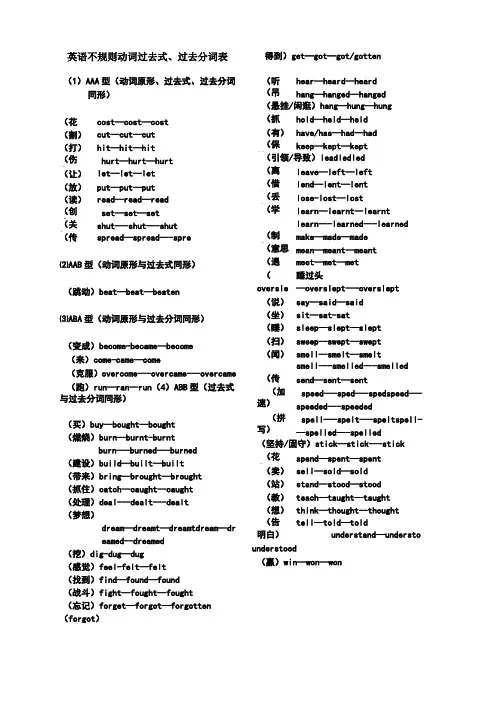
英语不规则动词过去式、过去分词表得到)get—got—got/gotten(1)AAA型(动词原形、过去式、过去分词同形)(花费)cost—cost—cost(割)cut—cut—cut (打)hit—hit—hit(伤害)hurt—hurt—hurt(让)let—let—let (放)put—put—put (读)read—read—read(创建)set—set—set(关闭)shut---shut---shut(传播)spread—spread---spre ad⑵AAB型(动词原形与过去式同形)(跳动)beat—beat—beaten⑶ABA型(动词原形与过去分词同形)(变成)become-became—become(来)come-came—come(克服)overcome---overcame---overcame (跑)run—ran—run(4)ABB型(过去式与过去分词同形)(买)buy—bought--bought(燃烧)burn—burnt-burntburn---burned---burned(建设)build—built—built(带来)bring—brought—brought(抓住)catch--caught--caught(处理)deal---dealt---dealt(梦想)dream—dreamt—dreamtdream—dreamed--dreamed(挖)dig-dug—dug(感觉)feel-felt—felt(找到)find—found—found(战斗)fight--fought--fought(忘记)forget—forgot—forgotten (forgot)(听hear—heard--heard(吊死)hang—hanged—hanged (悬挂/闲逛)hang—hung—hung(抓住)hold—held—held(有)have/has—had—had(保持)keep—kept—kept(引领/导致)leadledled(离开)leave—left—left(借出)lend—lent—lent(丢失)lose-lost—lost(学习)learn—learnt--learntlearn---learned---learned (制造)make—made—made(意思是mean—meant--meant(遇见)meet—met—met(睡过头oversleep—overslept---overslept (说)say—said—said(坐)sit—sat-sat(睡)sleep—slept—slept(扫)sweep—swept—swept(闻)smell—smelt—smeltsmell---smelled---smelled (传送)send—sent—sent(加速)speed---sped---spedspeed---speeded---speeded(拼写)spell---spelt---speltspell---spelled---spelled(坚持/固守)stick—stick---stick(花费)spend—spent—spent(卖)sell—sold—sold(站)stand—stood—stood(教)teach—taught--taught(想)think—thought--thought(告诉)tell—told—told明白)understand—understo understood(赢)win—won—won开始)(吹)打破选择做)喝)画)驾驶吃)落下飞)给)去)生长隐藏知道)(5)ABC 型(动词原形、过去式与过去分词三者不同形)begin —began —begunblow —blew —blown break —broke —brokenchoose —c hose —chosendo —did —done drink —drank —drunkdraw —drew —drawndrive —drove —driveneat —ate —eatenfall —fell —fallen fly —flew —flowngive —gave —g ivengo —went —gone grow —grew —grownhide---hid---h iddenknow —knew —known(放置产卵下蛋)lay —laid--laid (平躺位于)lie —lay —lain (说谎)lie---lied---lied(弄错)mistake —mistook —mistaken (铃响)ring —rang —rung (骑)ride —rode —ridden (升高)rise —rose —risen (摇)shake---shook —shaken (偷)steal —stole--stolen (唱)sing —sang —sung (游泳)swim —swam —swum (出示)show —showed —shown (看见)see —saw —seen(说,讲)speak —spoke —spoken (取)take —took —taken (投掷throw —threw —thrown (醒)wake —woke —woke (穿)wear —wore —worn (写)write —wrote —written be (am,is,are )(是)was,werebeen。
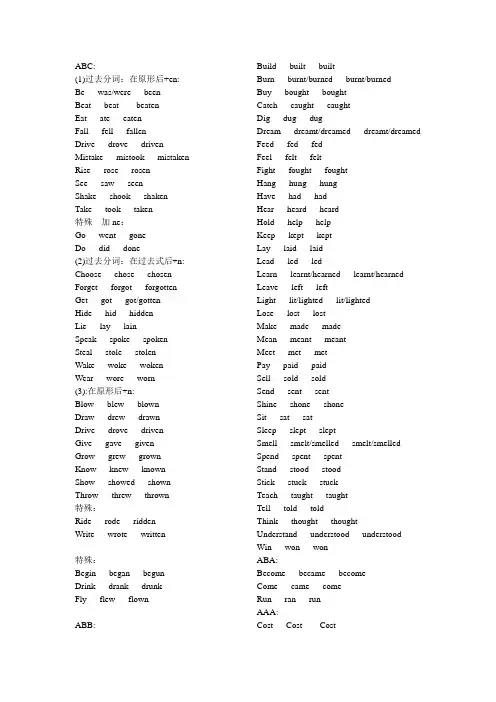
ABC:(1)过去分词:在原形后+en: Be was/were beenBeat beat beatenEat ate eatenFall fell fallenDrive drove driven Mistake mistook mistaken Rise rose rosenSee saw seenShake shook shaken Take took taken特殊加ne:Go went goneDo did done(2)过去分词:在过去式后+n: Choose chose chosen Forget forgot forgotten Get got got/gottenHide hid hiddenLie lay lainSpeak spoke spoken Steal stole stolenWake woke woken Wear wore worn (3):在原形后+n:Blow blew blownDraw drew drawnDrive drove drivenGive gave givenGrow grew grownKnow knew known Show showed shown Throw threw thrown特殊:Ride rode riddenWrite wrote written特殊:Begin began begun Drink drank drunkFly flew flownABB: Build built builtBurn burnt/burned burnt/burnedBuy bought boughtCatch caught caughtDig dug dugDream dreamt/dreamed dreamt/dreamed Feed fed fedFeel felt feltFight fought foughtHang hung hungHave had hadHear heard heardHold help helpKeep kept keptLay laid laidLead led ledLearn learnt/hearned learnt/hearned Leave left leftLight lit/lighted lit/lightedLose lost lostMake made madeMean meant meantMeet met metPay paid paidSell sold soldSend sent sentShine shone shoneSit sat satSleep slept sleptSmell smelt/smelled smelt/smelled Spend spent spentStand stood stoodStick stuck stuckTeach taught taughtTell told toldThink thought thoughtUnderstand understood understoodWin won wonABA:Become became becomeCome came comeRun ran runAAA:Cost Cost CostHit Hit hit Hurt hurt hurt Let let letPut put put Read read read set set set shut shut shut。
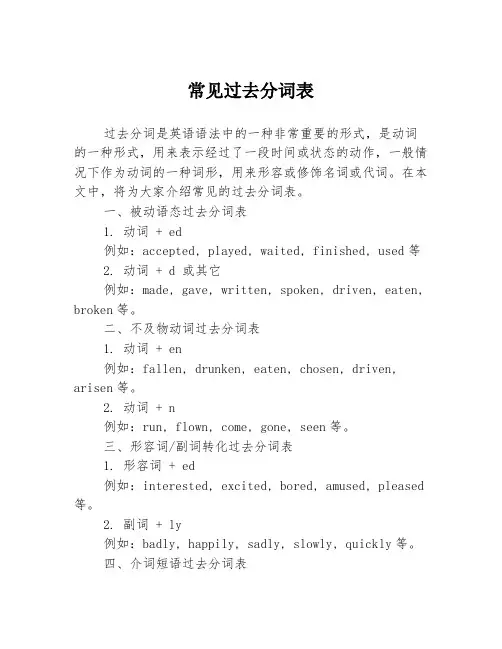
常见过去分词表过去分词是英语语法中的一种非常重要的形式,是动词的一种形式,用来表示经过了一段时间或状态的动作,一般情况下作为动词的一种词形,用来形容或修饰名词或代词。
在本文中,将为大家介绍常见的过去分词表。
一、被动语态过去分词表1. 动词 + ed例如:accepted, played, waited, finished, used等2. 动词 + d 或其它例如:made, gave, written, spoken, driven, eaten, broken等。
二、不及物动词过去分词表1. 动词 + en例如:fallen, drunken, eaten, chosen, driven, arisen等。
2. 动词 + n例如:run, flown, come, gone, seen等。
三、形容词/副词转化过去分词表1. 形容词 + ed例如:interested, excited, bored, amused, pleased 等。
2. 副词 + ly例如:badly, happily, sadly, slowly, quickly等。
四、介词短语过去分词表1. on time: arrived, left2. under pressure : stressed, worn-out3. in trouble : arrested, bankrupted4. with care : handled, packed5. with ease : lifted, moved五、常见过去分词表1. 感受/情感:amazed, bored, disappointed, confused, excited, fascinated, impressed, interested, surprised, shocked2. 行为/动作:broken, caught, dropped, eaten, fired, forgotten, made, read, thrown, written3. 形状/状态:bent, burned, cracked, folded, frozen, melted, ripped, torn, twisted, worn4. 意识/认知:believed, known, learned, heard, realized, thought, understood, seen5. 状态/情况:finished, closed, opened, arrived, gone, started, stopped, cancelled, delayed总结以上是常见的过去分词表,掌握这些词汇对于学习和掌握英语语法非常有帮助。
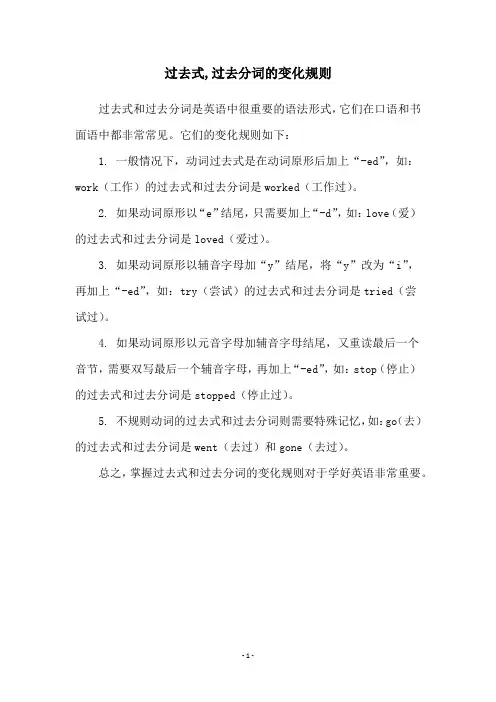
过去式,过去分词的变化规则
过去式和过去分词是英语中很重要的语法形式,它们在口语和书面语中都非常常见。
它们的变化规则如下:
1. 一般情况下,动词过去式是在动词原形后加上“-ed”,如:work(工作)的过去式和过去分词是worked(工作过)。
2. 如果动词原形以“e”结尾,只需要加上“-d”,如:love(爱)的过去式和过去分词是loved(爱过)。
3. 如果动词原形以辅音字母加“y”结尾,将“y”改为“i”,
再加上“-ed”,如:try(尝试)的过去式和过去分词是tried(尝
试过)。
4. 如果动词原形以元音字母加辅音字母结尾,又重读最后一个
音节,需要双写最后一个辅音字母,再加上“-ed”,如:stop(停止)的过去式和过去分词是stopped(停止过)。
5. 不规则动词的过去式和过去分词则需要特殊记忆,如:go(去)的过去式和过去分词是went(去过)和gone(去过)。
总之,掌握过去式和过去分词的变化规则对于学好英语非常重要。
- 1 -。
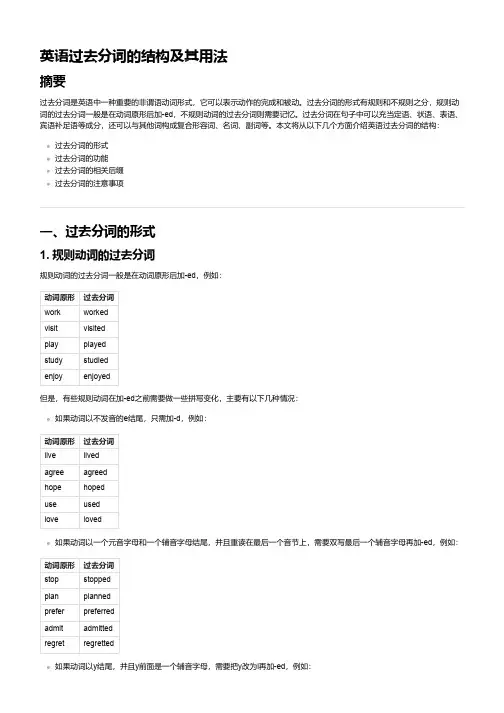
英语过去分词的结构及其用法摘要过去分词是英语中一种重要的非谓语动词形式,它可以表示动作的完成和被动。
过去分词的形式有规则和不规则之分,规则动词的过去分词一般是在动词原形后加-ed,不规则动词的过去分词则需要记忆。
过去分词在句子中可以充当定语、状语、表语、宾语补足语等成分,还可以与其他词构成复合形容词、名词、副词等。
本文将从以下几个方面介绍英语过去分词的结构:过去分词的形式过去分词的功能过去分词的相关后缀过去分词的注意事项一、过去分词的形式1. 规则动词的过去分词规则动词的过去分词一般是在动词原形后加-ed,例如:动词原形过去分词work workedvisit visitedplay playedstudy studiedenjoy enjoyed但是,有些规则动词在加-ed之前需要做一些拼写变化,主要有以下几种情况:如果动词以不发音的e结尾,只需加-d,例如:动词原形过去分词live livedagree agreedhope hopeduse usedlove loved如果动词以一个元音字母和一个辅音字母结尾,并且重读在最后一个音节上,需要双写最后一个辅音字母再加-ed,例如:动词原形过去分词stop stoppedplan plannedprefer preferredadmit admittedregret regretted如果动词以y结尾,并且y前面是一个辅音字母,需要把y改为i再加-ed,例如:动词原形过去分词study studiedcry criedtry triedcarry carriedworry worried2. 不规则动词的过去分词不规则动词的过去分词没有固定的规则,需要通过记忆来掌握。
不规则动词的过去分词可以根据其与原形和过去式之间的关系,大致分为以下几类:原形、过去式和过去分词完全相同,例如:动词原形过去式过去分词cut cut cuthit hit hitput put putread read readhurt hurt hurt原形和过去式相同,而过去分词不同,例如:动词原形过去式过去分词come come comebecome become becomerun run runwin win wonswim swim swum原形和过去分词相同,而过去式不同,例如:动词原形过去式过去分词build built builtburn burnt burntdream dreamt dreamtlearn learnt learntspoil spoilt spoilt原形、过去式和过去分词都不相同,例如:动词原形过去式过去分词be was/were beendo did donego went gonesee saw seenwrite wrote written原形和过去分词以n结尾,而过去式以w结尾,例如:动词原形过去式过去分词know knew knowngrow grew grownblow blew blownfly flew flowndraw drew drawn原形和过去分词以d结尾,而过去式以t结尾,例如:动词原形过去式过去分词build built builtlend lent lentsend sent sentspend spent spent原形和过去分词以e结尾,而过去式以a或o结尾,例如:动词原形过去式过去分词give gave giventake took takenmake made madebreak broke brokenspeak spoke spoken原形和过去分词以t结尾,而过去式以a结尾,例如:动词原形过去式过去分词teach taught taughtcatch caught caughtbuy bought boughtbring brought broughtthink thought thought原形和过去分词以n结尾,而过去式以a结尾,例如:动词原形过去式过去分词begin began begundrink drank drunksing sang sungring rang rungswim swam swum二、过去分词的功能过去分词在句子中可以充当多种成分,主要有以下几种功能:1. 构成被动语态过去分词可以与助动词be或get构成被动语态,表示主语是动作的承受者,而不是执行者。
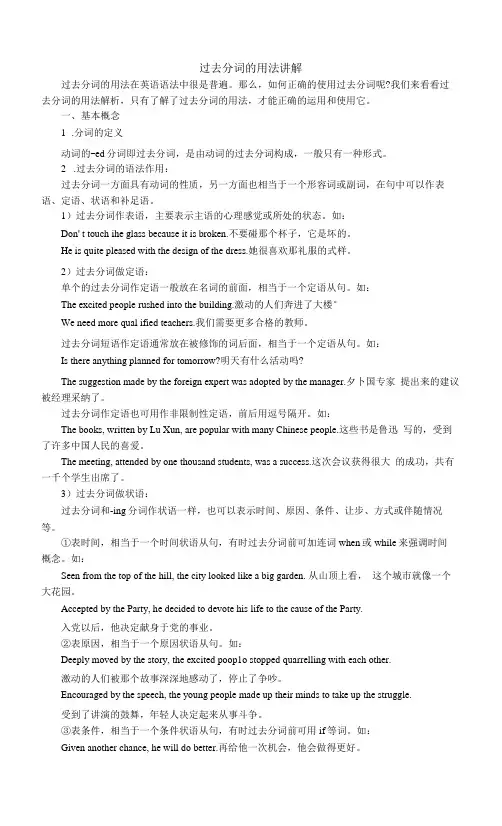
过去分词的用法讲解过去分词的用法在英语语法中很是普遍。
那么,如何正确的使用过去分词呢?我们来看看过去分词的用法解析,只有了解了过去分词的用法,才能正确的运用和使用它。
一、基本概念1.分词的定义动词的-ed分词即过去分词,是由动词的过去分词构成,一般只有一种形式。
2.过去分词的语法作用:过去分词一方面具有动词的性质,另一方面也相当于一个形容词或副词,在句中可以作表语、定语、状语和补足语。
1)过去分词作表语,主要表示主语的心理感觉或所处的状态。
如:Don' t touch ihe glass because it is broken.不要碰那个杯子,它是坏的。
He is quite pleased with the design of the dress.她很喜欢那礼服的式样。
2)过去分词做定语:单个的过去分词作定语一般放在名词的前面,相当于一个定语从句。
如:The excited people rushed into the building.激动的人们奔进了大楼°We need more qual ified teachers.我们需要更多合格的教师。
过去分词短语作定语通常放在被修饰的词后面,相当于一个定语从句。
如:Is there anything planned for tomorrow?明天有什么活动吗?The suggestion made by the foreign expert was adopted by the manager.夕卜国专家提出来的建议被经理采纳了。
过去分词作定语也可用作非限制性定语,前后用逗号隔开。
如:The books, written by Lu Xun, are popular with many Chinese people.这些书是鲁迅写的,受到了许多中国人民的喜爱。
The meeting, attended by one thousand students, was a success.这次会议获得很大的成功,共有一千个学生出席了。
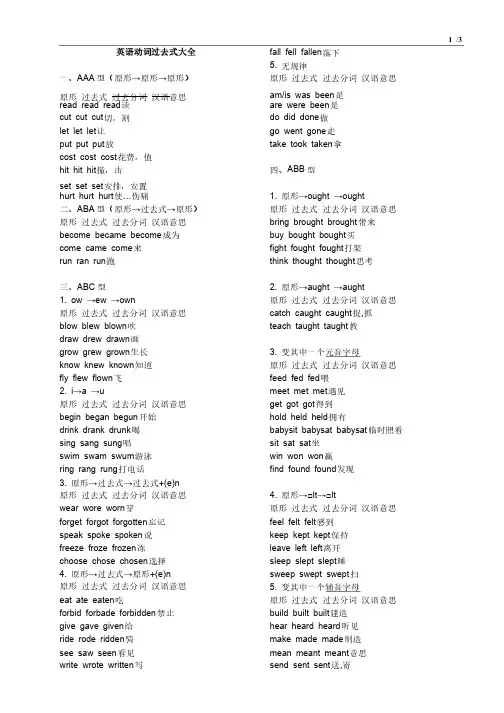
1 / 3 英语动词过去式大全一、AAA 型(原形→原形→原形)原形) 原形原形 过去式过去式 过去分词过去分词 汉语意思汉语意思 read read read 读 cut cut cut 切,割切,割切,割 let let let 让 put put put 放 cost cost cost 花费,值花费,值花费,值 hit hit hit 撞,击撞,击撞,击 set set set 安排,安置安排,安置安排,安置 hurt hurt hurt 使…伤痛伤痛二、ABA 型(原形→过去式→原形)原形) 原形原形 过去式过去式 过去分词过去分词 汉语意思汉语意思 become became become 成为成为 come came come 来 run ran run 跑三、ABC 型1. ow →ew →own 原形原形 过去式过去式 过去分词过去分词 汉语意思汉语意思 blow blew blown 吹 draw drew drawn 画 grow grew grown 生长生长生长 know knew known 知道知道知道 fly flew flown 飞2. i→a →u 原形原形 过去式过去式 过去分词过去分词 汉语意思汉语意思 begin began begun 开始开始开始 drink drank drunk 喝 sing sang sung 唱 swim swam swum 游泳游泳游泳 ring rang rung 打电话打电话打电话3. 原形→过去式→过去式+(e)n 原形原形 过去式过去式 过去分词过去分词 汉语意思汉语意思 wear wore worn 穿 forget forgot forgotten 忘记忘记 speak spoke spoken 说 freeze froze frozen 冻 choose chose chosen 选择选择4. 原形→过去式→原形+(e)n 原形原形 过去式过去式 过去分词过去分词 汉语意思汉语意思 eat ate eaten 吃forbid forbade forbidden 禁止禁止 give gave given 给 ride rode ridden 骑 see saw seen 看见看见看见 write wrote written 写fall fell fallen 落下落下落下 5. 无规律无规律 原形原形 过去式过去式 过去分词过去分词 汉语意思汉语意思 am/is was been 是 are were been 是 do did done 做 go went gone 走 take took taken 拿四、ABB 型1. 原形→ought →ought 原形原形 过去式过去式 过去分词过去分词 汉语意思汉语意思 bring brought brought 带来带来 buy bought bought 买 fight fought fought 打架打架打架 think thought thought 思考思考思考2. 原形→aught →aught 原形原形 过去式过去式 过去分词过去分词 汉语意思汉语意思 catch caught caught 捉,抓 teach taught taught 教3. 变其中一个元音字母变其中一个元音字母 原形原形 过去式过去式 过去分词过去分词 汉语意思汉语意思 feed fed fed 喂 meet met met 遇见遇见遇见 get got got 得到得到 hold held held 拥有拥有拥有 babysit babysat babysat 临时照看临时照看 sit sat sat 坐 win won won 赢 find found found 发现发现发现4. 原形→□lt→□lt 原形原形 过去式过去式 过去分词过去分词 汉语意思汉语意思 feel felt felt 感到感到感到 keep kept kept 保持保持保持 leave left left 离开离开离开 sleep slept slept 睡 sweep swept swept 扫 5. 变其中一个辅音字母变其中一个辅音字母 原形原形 过去式过去式 过去分词过去分词 汉语意思汉语意思 build built built 建造建造建造 hear heard heard 听见听见听见 make made made 制造制造制造 mean meant meant 意思意思意思 send sent sent 送,寄2 / 3 spend spent spent 花费花费花费 deal dealt dealt 处理处理6.辅音字母和元音字母都变辅音字母和元音字母都变 原形原形 过去式过去式 过去分词过去分词 汉语意思汉语意思 have had had 有,吃 lay lain lain 放 lose lost lost 丢失丢失丢失 pay paid paid 付钱付钱付钱 say said said 说 sell sold sold 卖tell told told 告诉告诉告诉 stand stood stood 站 五、AAB 型 原形原形 过去式过去式 过去分词过去分词 汉语意思汉语意思 beat beat beaten 打败打败 六、有两种形式六、有两种形式 原形原形 过去式过去式 过去分词过去分词 汉语意思汉语意思 bear bore born 生 bore borne hang hanged hanged 吊死吊死 hung hung 挂learn learned learned 学 learnt learnt lie lied lied 说谎说谎说谎 lay lain 躺show showed showed 给…看 showed shown spell spelled spelled 拼写拼写拼写 spelt spelt burn burned burned 烧 burnt burnt smell smelled smelled 闻 smelt smelt shine shined shined 照耀照耀照耀 shone shone dream dreamed dreamed 做梦做梦 dreamt dreamt wake waked waked 醒 woke woken hide hid hid 躲藏躲藏躲藏 hid hidden 七、情态动词七、情态动词 原形原形 过去式过去式 过去分词过去分词 汉语意思汉语意思 can could ⁄ 能 may might ⁄ 也许也许也许 must ⁄ ⁄ 必须必须必须 shall should ⁄ 将要将要将要 will would ⁄ 会初中英语不规则动词表(二)初中英语不规则动词表(二) 原形原形 过去式过去式 过去分词过去分词 汉语意思汉语意思 am/is was been 是 are were been 是 babysit babysat babysat 临时照看临时照看 bear bore born 生 bear bore borne 生 beat beat beaten 打败打败 become became become 成为成为 begin began begun 开始开始开始 blow blew blown 吹 bring brought brought 带来带来 build built built 建造建造建造 burn burned burned 烧 burn burnt burnt 烧 buy bought bought 买 can could ⁄ 能catch caught caught 捉,抓 choose chose chosen 选择选择选择 come came come 来 cost cost cost 花费,值花费,值花费,值 cut cut cut 切,割切,割切,割 deal dealt dealt 处理处理 dig dug dug 挖 do did done 做draw drew drawn 画dream dreamed dreamed 做梦做梦 dream dreamt dreamt 做梦做梦做梦 drink drank drunk 喝 drive drove driven 驾驶驾驶 eat ate eaten 吃 fall fell fallen 落下落下落下 feed fed fed 喂 feel felt felt 感到感到感到 fight fought fought 打架打架打架 find found found 发现发现发现 fly flew flown 飞原形原形 过去式过去式 过去分词过去分词 汉语意思汉语意思 forbid forbade forbidden 禁止禁止 forget forgot forgotten 忘记忘记 freeze froze frozen 冻 get got got 得到得到 give gave given 给3 / 3 go went gone 走grow grew grown 生长生长生长 hang hanged hanged 吊死吊死 hang hung hung 挂 have had had 有,吃 hear heard heard 听见听见听见 hide hid hid 躲藏躲藏躲藏 hide hid hidden 躲藏躲藏 hit hit hit 撞,击撞,击撞,击 hold held held 拥有拥有拥有 hurt hurt hurt 使…伤痛伤痛 keep kept kept 保持保持保持 know knew known 知道知道知道 lay lain lain 放learn learned learned 学 learn learnt learnt 学 leave left left 离开离开离开 lend lent lent 把…借给借给 let let let 让 lie lied lied 说谎说谎说谎 lie lay lain 躺 lose lost lost 丢失丢失丢失 make made made 制造制造制造 may might ⁄ 也许也许也许 mean meant meant 意思意思意思 meet met met 遇见遇见遇见 must ⁄ ⁄ 必须必须必须 pay paid paid 付钱付钱付钱 put put put 放 read read read 读原形原形 过去式过去式 过去分词过去分词 汉语意思汉语意思 ride rode ridden 骑 ring rang rung 打电话打电话打电话 run ran run 跑 say said said 说 see saw seen 看见看见看见 sell sold sold 卖 send sent sent 送,寄 set set set 安排,安置安排,安置安排,安置 shall should ⁄ 将要将要将要 shine shined shined 照耀照耀照耀 shine shone shone 照耀照耀 show showed showed 给…看 show showed shown 给…看 sing sang sung 唱sit sat sat 坐sleep slept slept 睡 smell smelled smelled 闻 smell smelt smelt 闻 speak spoke spoken 说 spell spelled spelled 拼写拼写拼写 spell spelt spelt 拼写拼写拼写 spend spent spent 花费花费花费 stand stood stood 站 sweep swept swept 扫 swim swam swum 游泳游泳游泳 take took taken 拿 teach taught taught 教 tell told told 告诉告诉告诉 think thought thought 思考思考思考 wake waked waked 醒 wake woke woken 醒 wear wore worn 穿 will would ⁄ 会 win won won 赢 write wrote written 写。

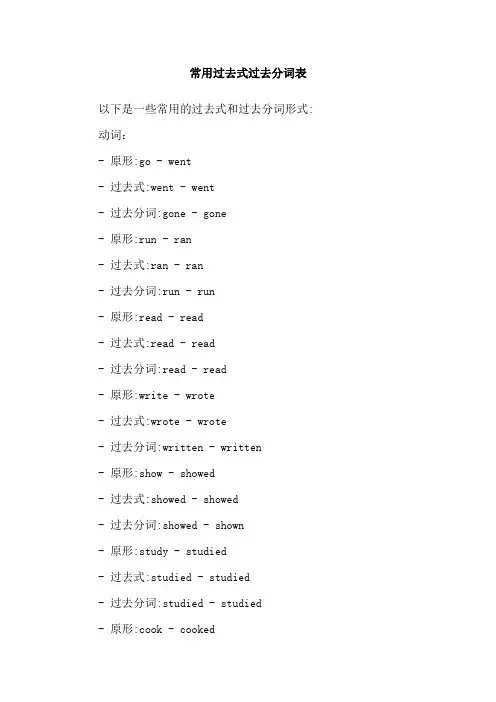
常用过去式过去分词表以下是一些常用的过去式和过去分词形式: 动词:- 原形:go - went- 过去式:went - went- 过去分词:gone - gone- 原形:run - ran- 过去式:ran - ran- 过去分词:run - run- 原形:read - read- 过去式:read - read- 过去分词:read - read- 原形:write - wrote- 过去式:wrote - wrote- 过去分词:written - written- 原形:show - showed- 过去式:showed - showed- 过去分词:showed - shown- 原形:study - studied- 过去式:studied - studied- 过去分词:studied - studied- 原形:cook - cooked- 过去式:cooked - cooked - 过去分词:cooked - cooked 形容词:- 原形:happy - happy- 过去式:happy - happy- 过去分词:happy - happy - 原形:sick - sick- 过去式:sick - sick- 过去分词:sick - sick副词:- 原形:soon - soon- 过去式:soon - soon- 过去分词:soon - soon- 原形:last - last- 过去式:last - last- 过去分词:last - last- 原形:hard - hard- 过去式:hard - hard- 过去分词:hard - hard介词:- 原形:in - in- 过去式:in - in- 原形:on - on- 过去式:on - on- 过去分词:on - on- 原形:under - under- 过去式:under - under - 过去分词:under - under 代词:- 原形:me - me- 过去式:me - me- 过去分词:me - me- 原形:you - you- 过去式:you - you- 过去分词:you - you- 原形:he - he- 过去式:he - he- 过去分词:he - he- 原形:she - she- 过去式:she - she- 过去分词:she - she- 原形:it - it- 过去式:it - it- 原形:we - we- 过去式:we - we- 过去分词:we - we- 原形:they - they- 过去式:they - they- 过去分词:they - they。
过去分词表过去分词是英语语法中的一种形式,它通常表示动作或状态已经完成,或是被动的动作或状态。
下面是常见的过去分词表,供大家参考。
一般规则动词的过去分词:1. 常规加-ed:walked, talked, played, loved2. 以不发音的“e”结束的动词加-d:lived, loved, saved, hoped3. 以辅音字母+y结尾的动词变y为i后再加-ed:carried, studied, tried, cried4. 双写最后一个辅音字母再加-ed:stopped, planed, hugged, nodded一些不规则动词的过去分词:1. be(was, were) been2. become became become3. begin began begun4. bring brought brought5. buy bought bought6. choose chose chosen7. come came come8. do did done9. draw drew drawn10. drink drank drunk11. drive drove driven12. eat ate eaten13. fall fell fallen14. feel felt felt15. find found found16. fly flew flown17. forget forgot forgotten18. get got got/gotten19. give gave given20. go went gone21. grow grew grown22. have had had23. hear heard heard24. hit hit hit25. hold held held26. keep kept kept27. know knew known28. leave left left29. lend lent lent30. let let let31. lose lost lost32. make made made33. meet met met34. pay paid paid35. put put put36. read read read37. ride rode ridden38. ring rang rung39. run ran run40. say said said41. see saw seen42. sell sold sold43. send sent sent44. sing sang sung45. sit sat sat46. sleep slept slept47. speak spoke spoken48. spend spent spent49. stand stood stood50. swim swam swum除了以上列出的常用动词,还有一些不太常见的不规则动词过去分词形式可能需要单独记忆。
过去分词过去分词(Past Participle)是分词的一种。
规则动词的过去分词一般是由动词加ed构成(规则见后),不规则动词的过去分词见不规则动词表。
过去分词属于类动词: 1. 及物动词的过去分词作表语,与句子的主语是被动关系,表示主语的状态,不但表示被动,还表示已完成了。
The cup is broken. 茶杯破了。
2. 不及物动词的过去分词作表语,与句子的主语是主动关系,表示主语的状态,只表示动作的完成。
He is retired. 他已退休。
3. 有些过去分词作表语时,构成的谓语很接近被动结构。
1构成规则构成1.规则动词:规则动词的过去分词的构成规则与规则动词的过去式的构成规则相同。
四点变化规则:(1)、一般动词,在词尾直接加“ ed ”。
(然而要注意的是,过去分词并不是过去式)work---worked---worked,visit---visited---visited(2)、以发音的“ e ”结尾的动词,只在词尾加“ d ”。
live---lived---lived(3)、以“辅音字母 + y ”结尾的动词,将 "y" 变为 "i" ,再加“ ed ”。
study---studied---studied,cry---cried---cried,try---tried---tried,fry---fried---fried.[1] (4)、重读闭音节结尾,末尾只有一个辅音字母,先双写该辅音字母,再加“ ed ”。
stop---stopped---stopped,drop---dropped--dropped】(5)、以ic结尾的动词,要把ic变成ick再加ed,如picnic→picnicked,traffic→trafficked2 、不规则动词,见不规则表作表语The city is surrounded on three sides by mountains. 这座城市三面环山。
过去分词的四种形式过去分词是英语中不可或缺的语法形式之一,常用于被动语态和完成时态,而其四种形式则在不同语境下略有变化。
下文将为您详细介绍这四种形式并提供实例,帮助您更好地理解和使用它们。
第一种形式:V-ed这种形式是最基本的过去分词形式,通常用来描述完成的动作或被动的事件。
例如:- The door was opened by him. –门被他打开了。
- She was not satisfied with the food served. –她不满意上菜的食物。
第二种形式:V-en这种形式较少用于被动语态,更多用于完成时态。
例如:- I have eaten breakfast already. –我已经吃过早餐了。
- The house has been taken down. –这座房子已经被拆除了。
第三种形式:V-t,V-ne这两种形式也属于过去分词形式,但不同于前两种形式,它们通常表示不同的语意和用法。
第三种形式中的V-t通常用于描述进行中的动作,类似现在分词的用法。
例如:- The boy was playing basketball in the park. –那个男孩正在公园里打篮球。
- She was practicing the piano for an hour. –她弹了一个小时的钢琴。
第四种形式中的V-ne则常用于被动语态和完成时态。
例如:- The tree has been shaken by the strong wind. –这棵树被大风摇晃了。
- My homework had been finished before dinner. –我在晚餐前已经完成了作业。
综上所述,掌握过去分词的不同形式对于学好英语语法和写作至关重要。
通过学习不同形式的用法和实例,我们可以更准确地表达自己的观点,提高自己的英语写作水平。
过去分词用法总结过去分词是动词的另一种非限定形式,在句中可以作定语、表语、宾语补足语和状语。
一、过去分词作定语1. 一般情况下,单个分词作前置定语,过去分词短语作后置定语。
如:a used car旧车,a playground built last year去年修建的一个操场。
2. 及物动词的过去分词表示“被动”和完成”。
Many people questioned refused to answer. 被问的许多人都拒绝回答。
Five people won the “China’s Green Figure” award, a title given to ordinary people for their contributions to environmental protection. 五人获得了“中国绿色人物奖”,这是一个颁给对环保有贡献的普通人物的奖项。
3. 不及物动词的过去分词作前置定语,只表示“完成”,不表示被动。
如:the risen sun已升起的太阳,fallen leaves落叶。
4. astonish, disappoint, encourage, excite, frighten, interest, move, please, puzzle, satisfy, surprise, tire等表示心理状态的动词的过去分词作定语,表示被修饰的词所具有的特征,意为“感到……的”。
(其现在分词表示所修饰的词本身所处的状态,意为“令人……的”)。
Mr. Smith, tired of the tiring speech, started to read a novel. 史米斯先生厌倦了乏味的演讲,开始读小说。
This is a boring lecture. 这是一个令人厌烦的报告。
The excited children couldn't go to sleep all night long.这些兴奋的孩子整个晚上无法入睡。
过去式过去分词变化规则过去式和过去分词是英语中常见的动词形式。
它们在句子中的使用方式和变化规则有一些区别。
一、过去式的变化规则1. 一般情况下,动词的过去式是在词尾加上-ed。
例如:walk - walked, talk - talked。
2. 以不发音的-e结尾的动词,直接加上-d。
例如:live - lived, dance - danced。
3. 以重读闭音节结尾的单词,如果末尾只有一个辅音字母,则双写这个辅音字母,再加上-ed。
例如:stop - stopped, plan - planned。
4. 以辅音字母+y结尾的动词,将y变为i,再加上-ed。
例如:study - studied, try - tried。
5. 以辅音字母+元音字母+辅音字母结尾的重读闭音节单词,双写最后一个辅音字母,再加上-ed。
例如:admit - admitted, prefer - preferred。
6. 不规则动词的过去式需要特殊记忆,例如:go - went, have - had。
二、过去分词的变化规则1. 一般情况下,动词的过去分词是在词尾加上-ed。
例如:play - played, work - worked。
2. 以不发音的-e结尾的动词,直接加上-d。
例如:live - lived, dance - danced。
3. 以辅音字母+y结尾的动词,将y变为i,再加上-ed。
例如:study - studied, try - tried。
4. 以辅音字母+元音字母+辅音字母结尾的重读闭音节单词,双写最后一个辅音字母,再加上-ed。
例如:admit - admitted, prefer - preferred。
5. 不规则动词的过去分词需要特殊记忆,例如:go - gone, have - had。
过去式和过去分词在句子中的使用方式也有一些区别。
过去式通常用来表示过去发生的动作或状态,而过去分词则可以用作动词的补语、形容词或短语的一部分。
精心整理英语过去式大全我要中小学的要所有特殊变化的比如说+D去Y加IED把I,E变成A等写的详细点规则动词的过去式词尾变化有几种:1.一般情况下加ed,如watched,planted,watered,pulled,climbed,picked。
2.以不发音字母e结尾的加d,如liked,moved,tasted。
3.以辅音字母加y结尾的变y为i再加ed,如study——studied。
4.以1个元音字母加1个辅音字母结尾的重读闭音节,双写最后一个辅音字母再加ed,如stop——stopped。
abc.在sitdrinksingbeginswimgiveringrunridewritedrivekeepsleepfeelcometake1)2)begin——beganring——rangdrink——drankswim——swamgive——gave sing——sangsit——satrun-——ranhave——hadmake——madecome——cameeat——ate3)write——wroteride——rodespeak——spokedrive——drovestand——stood tell——toldwin——wonget——gottake——took4)sleep——sleptsweep——sweptfeel——feltkeep——kept spell——speltspend——spentbend——bentmeet——metgo——went5)know——knewfly——flewblow——blewgrow——grewthrow——threwdraw——drew(glow——glowed)6)teach——taughtcatch——caughtbuy——boughtfight——foughtthink——thought7)find——foundhear——heardsay——saidlie——lay see——sawlearn——learntmean——meant8)put——putread——readcut——cutlet——let如果是陈述句,就把动词变为过去式,一般都是加ed,有的特殊变化。
语法专项—过去分词的用法一周强化一、过去分词的定义及其基本形式1.过去分词是动词的另一种非限定形式,过去分词具有动词、形容词和副词的特性,可以带宾语或受状语修饰。
过去分词和宾语或状语一起构成过去分词短语。
如:(1)spoken English 英语口语(过去分词具有形容词的特性,作定语)(2)Given more time, we could do it much better.=If we were given more time, we could do it much better.多给点时间,我们会做得更好些。
(过去分词具有动词的特性,有自己的宾语more time,构成分词短语;过去分词短语在句中作状语,(2)不规则动词的过去分词须逐个记忆。
(3)不规则动词的过去分词表示完成,如:fallen leaves =leaves which have fallen落叶(4)及物动词的过去分词表示被动或完成,如:the machines used in the workshop=the machines which are used in the workshop车间用的机器(及物动词的过去分词表示被动)I heard the door opened.=I heard the door has been opened.我听见门被打开了。
(及物动词的过去分词表示被动和完成)二、过去分词的句法功能过去分词是一种非谓语动词,在句中不能单独做谓语。
但它具有形容词和副词的特性,故在句中可以作定语、表语、宾语补足语和状语。
(一)定语作定语用的过去分词如果是单个的词,就放在被修饰的词的前面;若为分词短语则放在所修饰的词的后面。
如:The excited children are opening their Christmas presents.兴奋的孩子们正在打开他们的圣诞礼物。
Some of the people invited (=who have been invited) to the party can’t come.有些被邀请参加晚会的人不能来。
注意:(1)做定语用的过去分词通常指已完成的动作,若要表示现在进行的动作则要用过去分词的进行形式。
We must keep a secret of the things being discussed here.=We must keep a secret of the things which are being discussed here.我们必须对这里讨论的问题保密。
(2)如指未来的情况,都用不定式的被动形式。
He prepared some poems to be recited at the English evening.他准备了几首将在英语晚会上朗诵的诗。
例1.The computer centre, ______ last year, is very popular among the students in this school.A.open B.openingC.having opened D.opened答案与简析:选D。
过去分词短语作后置定语,相当于非限制性定语从句which was opened.(二)表语Be prepared! 做好准备!Everybody got excited about the boat trip.大家对坐船游览倍感兴奋。
注意:“be+过去分词”与被动语态的区别:“be+过去分词”表示状态;被动语态表示一个动作。
如:The bank is closed now.银行现在已经关门了。
(表状态)He had been injured during the war.他是在战争中受伤的。
(表动作)(三)宾(主)语补足语What made you so frightened?什么使你这样惊恐?He was found injured at the foot of a cliff.他被发现在山岩脚下受了伤。
例2.The managers discussed the plan that they would like to see ______ the next year.A.carry out B.carrying outC.carried out D.to carry out答案与简析:选C。
过去分词短语在定语从句中作宾补。
(四)做状语1.Born into a peasant family (=As he was born into a peasant family), he had only two years of schooling.(由于)他出生于农民家庭,他只上了两年学。
2.United we stand, divided we fall.=(If we are) United we stand and (If we are divided) we fall.团结则存,分裂则亡。
3.We went home exhausted.我们筋疲力尽地回到了家里。
4.分词有时和连词一起用,相当于状语从句的省略。
Robbie had arranged for this man to come whenever (he was) needed.罗比已安排好,随时需要这人就可以来。
例3.The child complained that the old man made no answer when _____ where he lived.A.asking B.askedC.to ask D.having asked答案与简析:选B。
状语从句的省略when (he was) asked.三、现在分词与过去分词的区别现在分词与过去分词都能作表语、定语、状语和补语。
现在分词表示主动、进行;过去分词表示被动、完成。
1.作表语:现在分词表示主语的性质,过去分词表示主语的状态。
(1)The film is very moving.这部电影很感人。
(表性质,主语本身怎样)(2)My hair is sold and gone.我的头发卖了,不见了。
(表示状态“不复存在”)例4.Mrs. Bush stood _______ for a moment when an old soldier suddenly appeared before her.A.surprised B.surprisingC.being surprised D.to be surprise答案与简析:选A。
stood为半系动词,surprised意为“吃惊的”,表示stood的状态。
2.作定语分词作定语,其逻辑主语是被修饰的词。
逻辑主语与分词是主动关系时,就用现在分词;是被动关系时,就用过去分词。
(1)The books dealing with the Long March are sold out.=The books which deal with the Long March are sold out.有关长征的书售完了。
(2)The books written by Guo Jinming are popular with young people.=The books which were written by Guo Jinming…郭敬民写的书很受年青人的欢迎。
例5.No computer so far ______ can have the same ability as human rights. A.be built B.having builtC.being built D.built答案与简析:选D。
build与no computer之间存在被动关系。
3.作状语分词作状ience.他提高了声2.have+宾语+过去分词(宾补)有三种情形:(1)I had my hair cut yesterday.昨天我理发了。
(have sth. done =ask sb. else to do)(2)I had my wallet stolen yesterday.昨天我钱包被偷了。
(have sth. done 遭受……)(3)I have my homework finished.我已经完成了家庭作业。
(完成式的强调)例7.TV has so many advantages. It keeps us ______ about the ______ news, and also provides entertainment in the home.A.informed; latest B.informed; laterC.informing; later D.informing; latest答案与简析:选A。
inform与宾语us之间存在被动关系,故用过去分词作宾补。
(二)感观动词表示感觉和心理状态的词,如see, hear, feel, watch, notice, observe, find, look at, listen to 这些动词所带的宾语后可以接过去分词作宾语补足语。
如:I saw a girl knocked down by a truck.我看见一个女孩被一辆卡车撞倒。
When I came in, I found the glass broken.当我进来的时候,我发现玻璃被打碎了。
例8.Yesterday I saw a man _____ in the street with a little boy ____ on hisshoulder.A.walking; seating B.walk; satC.walking; seated D.to walk; sitting答案与简析:选C。
第一空宾语a man为动作发出者故用walking;第二空seat为“使……坐下”,故用过去分词seated“坐下”,或sitting,综合两空选C。
(三)其它的动词wish, want, like, expect+宾语+过去分词(宾补)We wished the problem settled at once!我们希望问题马上解决。
五、独立主格结构(一)独立主格结构的构成1.名词或代词+分词/不定式/形容词/副词/介词短语构成。
2.独立主格结构没有主语和谓语,所以在语法上不是句子。
3.独立主格结构在句中起方式、时间、条件等状语或状语从句的作用。
4.独立主格结构前可用with变成with+名词/代词+分词/形容词/副词/介词短语的复合结构,在句中也可作定语。
(二)(with)名词/代词+分词(doing或done)结构这种结构的功能相似于分词或分词短语作状语,分词的逻辑主语是句子的主语,而独立结构中doing(done)的逻辑主语是它前面的名词或代词。